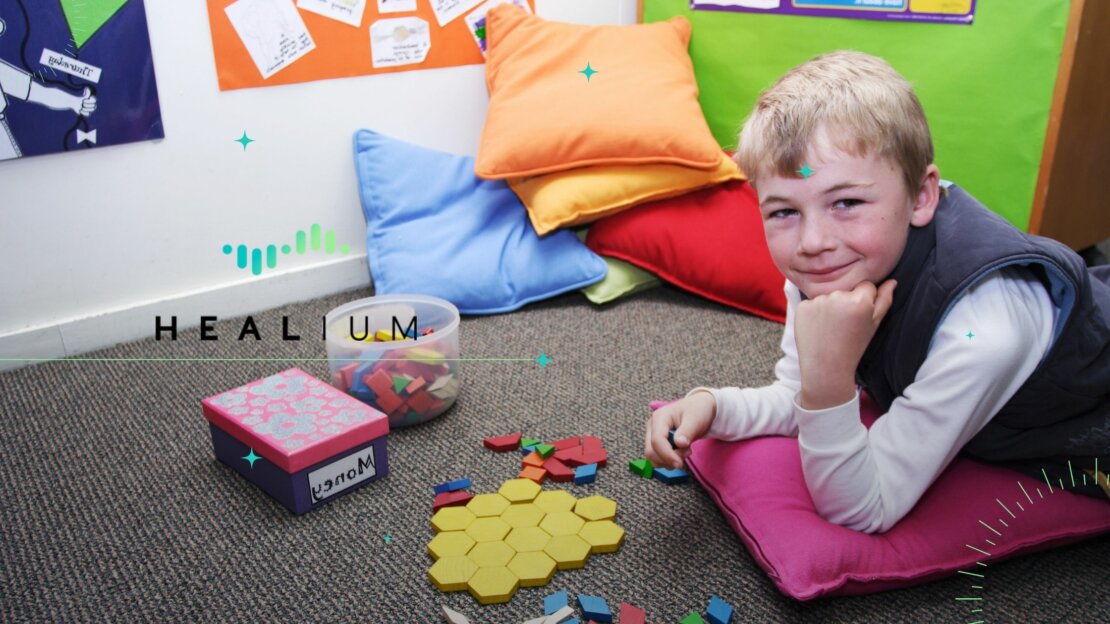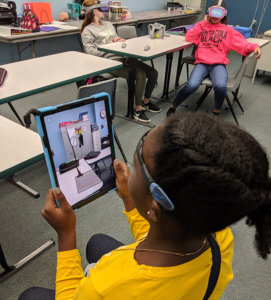




Elevate classroom emotional wellness with calm corners and Healium.

Emotional regulation plays a pivotal role in students’ ability to focus, engage, and succeed academically. Yet, it’s often overlooked in traditional classroom settings. Enter the concept of calm corners—a revolutionary approach to emotional management and self-regulation within the four walls of a classroom.
Calm corners are designated, thoughtfully designed spaces that offer students a place to pause, reflect, and recalibrate their emotions. Far from being a timeout spot, these areas are equipped with tools and resources aimed at empowering students to independently manage their emotional states.
This strategy not only acknowledges the student’s emotional well-being but also equips them with the skills necessary for lifelong resilience and success.
Traditionally, the response to emotional outbursts or disruptive behavior was often punitive—timeouts and detentions being common. However, these methods don’t teach students how to manage their emotions or cope with stress.
Calm corners emerge from the understanding that students need to be taught emotional regulation as a skill, much like reading or math. This philosophy pivots from punishment to empowerment, providing students with a space to learn about and practice self-regulation.
It’s about recognizing emotions as natural and teaching students positive ways to handle them. This approach not only supports emotional growth but also fosters a more compassionate and understanding classroom environment.
For Students:
• Improved Focus: By taking a moment to decompress and manage their emotions, students can return to their tasks with increased concentration and a clearer mind.
• Reduced Disruptive Behavior: Calm corners offer a proactive approach to managing emotional outbursts, reducing classroom disruptions and creating a more conducive learning environment.
• Empowerment: Students learn to recognize their emotional triggers and are equipped with tools to manage them, fostering a sense of control and resilience.
For Teachers:
• Enhanced Classroom Management: With fewer disruptions and a strategy in place for emotional regulation, teachers can maintain a smoother, more effective teaching flow.
• Positive Relationships: By supporting students in managing their emotions, teachers build trust and stronger connections with their students, enhancing the overall classroom atmosphere.
• Professional Satisfaction: Watching students develop emotional intelligence and self-regulation skills can be deeply rewarding, contributing to a teacher’s sense of accomplishment and job satisfaction.
The first step in creating a calm corner is selecting the right spot in your classroom. The ideal location meets three key criteria: accessibility, privacy, and supervision. A corner or space that is apart from high-traffic areas but within the teacher’s line of sight works best.
An effective calm corner is also equipped with resources and tools that cater to various sensory and emotional needs. Some frequently utilized items include:
• Fidget Toys: Offer a range of fidget toys to help students channel restless energy.
• Comfort Items: Include soft pillows, blankets, or stuffed animals for comfort.
• Breathing Guides: Use visuals or tools like pinwheels to encourage deep breathing exercises.
• Sensory Bins: Fill bins with sand, rice, or beads for tactile exploration.
• Visual Relaxation Prompts: Posters of nature scenes or calming patterns can provide visual distraction and relaxation.
• Emotion Cards: Help students identify and articulate their feelings with illustrated emotion cards.
• Quiet Activities: Provide books, puzzles, or coloring materials for solitary, calming activities.
To ensure the calm corner remains a supportive and effective space for emotional regulation, it’s crucial to establish clear guidelines. These rules are designed to maximize the benefits of the calm corner while maintaining the flow of classroom activities:
• Purpose: Clarify the calm corner is for self-regulation, not avoidance of class work.
• Time Limit: Set a reasonable duration for each visit to maintain its effectiveness.
• Usage Notification: Implement a simple system for students to indicate their need to use the space, minimizing class disruption.
Effective calm corners also require ongoing commitment and attention from the teacher themselves. When implementing a calm corner in your classroom, you should:
• Monitor Usage: Watch for patterns indicating the corner’s impact and any individual needs.
• Gather Feedback: Ask students what works or doesn’t, adjusting based on their experiences.
• Update Resources: Keep the space dynamic by refreshing with new tools and activities as needed.
• Adapt Rules: Be ready to tweak guidelines to fit changing classroom dynamics or student needs.
As we’ve explored the transformative impact of calm corners in fostering emotional regulation and resilience among students, it’s clear that the right tools and resources are key to their success. While calm corners are a fantastic start, incorporating advanced tools like Healium can take your classroom’s emotional wellness to the next level.
 Think of Healium as a virtual calm corner that teaches children how to down-shift their emotions from a heightened state into a relaxed state of calm. Healium offers a unique blend of mindfulness experiences and biofeedback technology, providing an immersive journey towards self-managed stress and anxiety relief.
Think of Healium as a virtual calm corner that teaches children how to down-shift their emotions from a heightened state into a relaxed state of calm. Healium offers a unique blend of mindfulness experiences and biofeedback technology, providing an immersive journey towards self-managed stress and anxiety relief.
Imagine a dedicated space in your school where students can not only pause and reflect but also engage with their emotional well-being in an interactive, impactful way. Healium has been embraced by educators and institutions worldwide, creating designated rooms that serve as advanced calm corners, where students can harness the power of their emotions and learn to navigate them with confidence.
Why Choose Healium for Your School?
• Engaging and Empowering: With its virtual reality capabilities, Healium offers an engaging way for students to learn about mindfulness and emotional regulation, making the concepts more accessible and impactful.
• Evidence-Based: Leveraging biofeedback, Healium provides real-time insights into one’s emotional state, offering a tangible way to measure and understand the effects of mindfulness practices.
•Versatile: Perfect for integration into existing calm corners or the creation of dedicated mindfulness spaces, Healium is versatile enough to suit various educational settings and needs.
To learn more about Healium’s impact in schools, watch the video below!
Are you ready to elevate your school’s approach to emotional well-being and mindfulness?
Explore how Healium can transform your calm corners into immersive, empowering spaces for emotional growth and resilience. Join the growing community of educators who are making mindfulness an integral part of their teaching strategy.
Contact us today to learn more about Healium and how it can benefit your students and school environment.
Sarah Hill, a former interactive TV news journalist at NBC, ABC, and CBS affiliates in Missouri, gained recognition for pioneering interactive news broadcasting using Google Hangouts. She is now the CEO of Healium, the world’s first biometrically powered VR/AR channel, helping those with stress, anxiety, insomnia, and other struggles through biofeedback storytelling. With patents, clinical validation, and over seven million views, she has reshaped the landscape of immersive media.